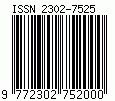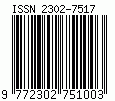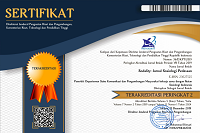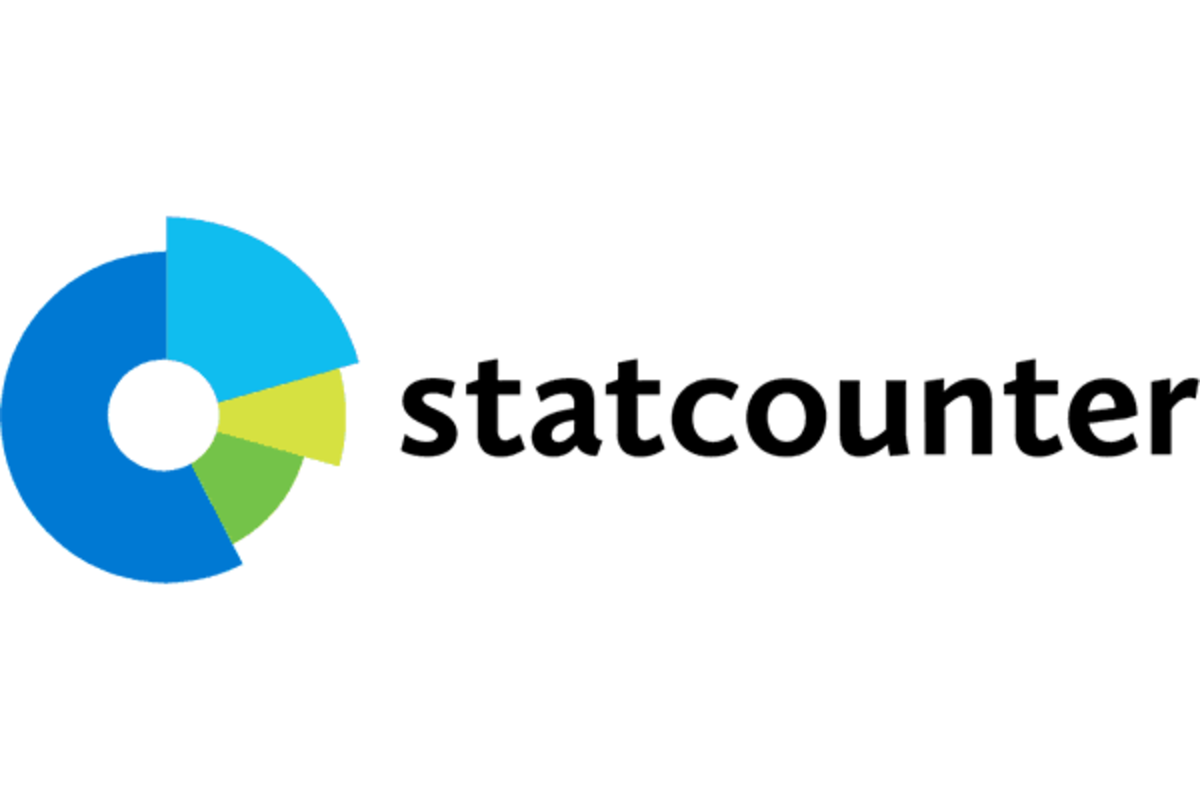The Correlation between Sociodemographic Characteristics and Chili Farmers' Knowledge on Pesticide Application in Tegal Regency
Abstract
Pest and disease are limiting factors in red chili cultivation. Chili farmers oftenuse synthetic pesticides to control pest and disease However, improper application of pesticide can cause deleterious effects to human and environment.The objective of research was to know the level of red chilli farmers understanding regardingpesticides use.This research was conducted in Bumijawa Subdistrict, Tegal District by interviewing farmers. A total number of 140 farmers werepurposely selected and divided into 4 groups, namely integrated pest management (IPM) monoculture,non IPM monoculture, IPM multiple cropping, and non IPM multiple cropping. Data analysis was performed using cross tabulation for likert scale questionnaire and Rank Spearman to analyze the relation among variables. Results showed that all four farmer groups had similar characteristics, i.e age range of 20-65 years, dominance ofelementary school graduates, and more than 10 years of farming experience. These group of farmers hadpositive score for application and safety principle of pesticide but they still had negative score on ecological aspect.Farmer’s age, level of education, and farming experience did not affect the knowledge of nonIPM monoculture and IPM monoculture groups. The level of education in non IPM multiple cropping group affected the application of pesticides. Farmer’s knowledge on pesticides usage and its safety application had significant correlation with farmer age and farming experience for IPM multiple cropping group.References
Agustian. A, Rachman. B. 2009. Penerapan teknologi pengendaalian hama terpadu pada komoditas perkebunan rakyat. Perspektif, Vol 8/1, pp. 30-4.
Aktar M. W, et al. 2009 Impact of pesticide use in agriculture: their benefit and hazards. Interdisc Toxicol. Vol. 2/1, pp. 1–12.
Andri, K. B. et al. 2016. Analisis usahatani dan pemasaran petani hotikultura di Bojonegoro. Jurnal LPPM Bidang EkoSosBudKum, Vol 3/2, pp.43-56.
Bayo, F. S. 2011. Impacts of Agricultural pesticides on terrestrial ecosystems. Ecological Impacts of toxic chemicals, pp. 63-87.
Black, L. L, et al. 1991. Pepper Diseases A Field Guidde. Taipe : [AVRDC] Asian Vegetable Research and Developmnet Centre.
BPS. 2013. Sensus Pertanian 2013. Jakarta (ID): BPS.
BPS. 2018. Produksi cabai merah besar, cabai merah rawit, dan bawang merah tahun 2018 Provinsi Jawa Tengah. [Internet]. [2019 Maret 16]. Diunduh dari : https://jateng.bps.go.id.
Charina, A. et al. 2018. Faktor-faktor yang mempengaruhi petani dalam menerapkan SOP sistem pertanian organik di Kabupaten Bandung Barat. Jurnal Penyuluhan, Vol 14/1, pp. 82-92.
Damayanti, W. A. et al. 2017. Hubungan motivasi dengan pendapatan petani cabai merah yang bermitra dengan binama hotikultura multiagromakmur di Kecamatan Ambulu Kabupaten Jember Jawa Timur. Jurnal Agritexts, Vol 41/2, pp. 142-153.
Dey, K. R. et al. 2013. Impact of pesticide use on the health of farmers: A study in Barak valley, Assam (India). Journal of Environmental Chemistry and Ecotoxicology, Vol 5/10, pp. 267-277.
FAO. 2017. Plant health and food security. [Internet]. [2018 Nov 12]. Diunduh dari: http://www.fao.org.
Indiati, S. W, Marwoto. 2017. Penerapan pengendalian hama terpadu (PHT) pada tanaman kedelai. Buletin Palawija, Vol 15/2, pp. 87-100.
Joko, T. et al. 2017. Pesticides usage in the soil quality degradation potential in wanasari subdistrict, Brebes, Indonesia. Applied and environtmental Soil Science, pp 1-7.
Kementan. 2018. Statistik Pertanian 2018. Jakarta (ID): Kementan.
Keys, E. 2004. Commercial agriculture as creative destructionor destructive creation: A case study of chili cultivation and plant pest disease in the Southern Yucatan region. Land Degradation & Development, Vol 15, pp. 397–409.
Kumari. P, Basavaraja. H. 2018. Perception of farmers and consumers on pesticide usi in Brinjal. IOSR Journal of Environmental Science, Toxicology and Food Technology, Vol 12/, pp. 38-44.
Manyamsari, I, Mujiburrahmad. 2014. Karakteristik petani dan hubungannya dengan kompetensi petani lahan sempit (Kasus : Di Desa Sinar Sari Kecamatan Dramaga Kab. Bogor Jawa Barat). Agrisep, Vol 15/2, pp. 58-74.
Midega, C. A, et al. 2012. Farmers' perceptions of cotton pests and their management in western Kenya. Crop Prot, Vol 42, pp. 193-201.
Moekasan, T. K. et al. 2004. Kelayakan teknis dan ekonomis penerapan teknologi pengendalian hama terpadu pada sistem tanam tumpanggilir bawang merah dan cabai merah. J.Hort, Vol 14/3, pp. 188-203.
Oluwole. O, Cheke, R. A. 2009. Health and environtmental impacts of pesticide use practices: A case study of farmers in Ekiti State, Nigeria. International Journal of Agricultural Sustainability, Vol 7/3, pp. 153-163.
Peraturan Pemerintah Nomor 6 Tahun 1996 tentang Perlindungan Tanaman.
Prayitno, W. et al. 2014. Hubungan pengetahuan, persepsi, dan perilaku petani dalam menggunakan pestisida pada lingkungan di Kelurahan Maharatu Kota Pekanbaru. Pusat penelitian lingkungan hidup Universitas Riau. pp 220-237.
Samosir, K. et al. 2017. Hubungan pajanan pestisida dengan gangguan keseimbangan tubuh petani hortikultura di Kecamatan Ngablak Kabupaten Magelang. J Kes Ling Indones, Vol 16/2, pp.63-69.
Sawitri D, Soepriadi, I. F. 2014. Modal sosial petani dan perkemangan industri di Desa Sentra Pertanian Kabupaten Subang dan Kabupaten Karawang. Jurnal Perencanaan Wilayah dan Kota, Vol 25/1, pp. 17-36.
Sembel, D. T. 2012. Dasar-Dasar Perlindungan Tanaman. Yogyakarta (ID) : Penerbit Andi.
Siwiendrayanti, A. et al. 2012. Hubungan riwayat pajanan pestisida dengan gangguan fungsi hati (studi pada wanita umur subur di Kecamatan Kersana Kabupaten Brebes). J Kes Masy Indonesia, Vol 11/1, pp. 9-14.
Soehardjo, Patong, D. 1984. Sendi-Sendi Pokok Ilmu Usaha Tani. Ujung Pandang [ID]: Universitas Hasanudin.
Sugiyono. 2013. Metode Penelitian Kombinasi (Mixed Methods). Bandung (ID): Alfabeta.
Sujaya, D. H. et al. 2018. Faktor-faktor yang berpengaruh terhadap produktivitas usahatani mina padi di Kota Tasikmalaya. Jurnal Pemikiran Masyarakat Ilmiah Berwawasan Agribisnis, Vol 4/1, pp. 25-39.
Turner, B. S [Editor]. 2009. Teori Sosial dari Klasik sampai Postmodern. Penerjemah; Setiyawati A. E, Shufiyanti, R. 2012. Yogyakarta (ID): Pustaka Pelajar.
Undang-Undang Nomor 12 tahun 1992 tentang Sistem Budidaya Tanaman.
Untung, K. 2007. Kebijakan Perlindungan Tanaman. Yogyakarta (ID) : Gadjah Mada University Press.
Wongkar, D. K. et al. 2016. Hubungan faktor-faktor sosial ekonomi pertanian dan tingkat adopsi inovasi budidaya padi di Desa Kembang Mertha Kecamatan Dumoga Timur, Kabupaten Bolaang Mongondow. Agri-sosioekonomi, Vol 12/2, pp. 15-32.
Authors who publish with this journal agree to the following terms:
- Authors retain copyright and grant the journal right of first publication with the work simultaneously licensed under a

This work is licensed under a Creative Commons Attribution 4.0 International License. that allows others to share the work with an acknowledgement of the work's authorship and initial publication in this journal. - Authors are able to enter into separate, additional contractual arrangements for the non-exclusive distribution of the journal's published version of the work (e.g., post it to an institutional repository or publish it in a book), with an acknowledgement of its initial publication in this journal.
- Authors are permitted and encouraged to post their work online (e.g., in institutional repositories or on their website) prior to and during the submission process, as it can lead to productive exchanges, as well as earlier and greater citation of published work (See The Effect of Open Access).




.png)










